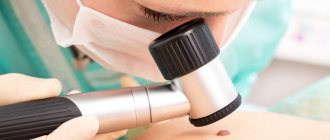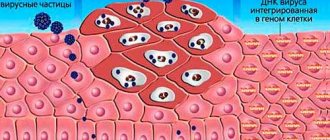The term papilloma defines a benign tumor that forms from skin cells or mucous membranes. The reason for its development is a specific human papillomavirus, which can be transmitted sexually or through household contact. Replication (division) of viruses leads to an increase in the activity of division of infected cells with the formation of characteristic formations (they are also called warts). The main method of treating papillomas is their removal using various modern physical techniques, including cryodestruction, electrocoagulation or laser therapy.
And is it possible to remove benign epidermal tumors on your own?
Having noticed specific neoplasms on the skin, which in medicine are called papillomas, many patients strive to cut or rip off the epidermal growth on their own, believing that such actions will lead to the disappearance of this defect. In addition, the Internet is actively discussing questions about what will happen if a papilloma is torn off and whether it is worth contacting a specialist if the papilloma comes off accidentally. Due to the relevance of such information, we will try to sort it out.
Recommendations for caring for the wound after papilloma removal
After removing the papilloma, a small wound in the form of a depression is formed in the area where it is localized. It is covered with a crust consisting of fibrin threads, leukocytes (cells of the immune system) and protects the wound from infection. Basic skin care measures after papilloma removal are aimed at preventing damage to the crust. To do this, it is important to follow a few simple recommendations, which include:
- After taking a shower, the skin area around the wound should not be wiped with a towel; it should be allowed to air dry.
- You cannot use any cosmetics, as they can irritate the cells in the area of the removed papilloma.
- Mechanical impact (usually in the form of friction with clothing) leads to additional trauma and significantly worsens the healing process of the wound, so it is important to ensure that clothing does not touch the skin of the area of the removed papilloma.
- It is important to avoid insolation of the skin, since the ultraviolet spectrum of sunlight or a solarium causes burns to unprotected tissues of the area of the procedure, and can also provoke malignant degeneration of other nevi (the largest amount of ultraviolet spectrum of sunlight is observed before lunch).
A consultation with a dermatologist allows you to learn in detail about the recommendations for caring for the wound after papilloma removal. Also, if necessary, the doctor prescribes special antiseptics that prevent infection. Self-use of such products is not recommended, since not all antiseptics are suitable for skin care after papilloma removal.
The duration of restrictions and recommendations for wound care after removal of papilloma is on average several days. It is recommended to avoid excessive sun exposure for a longer period of time, about a month. Also, for faster tissue healing, it is recommended to eat foods high in vitamins and essential amino acids, in particular lean meats, vegetables and fruits.
What happens if you tear off a papilloma
When considering skin growths such as papillomas, it should be clarified that such neoplasms are exclusively viral in nature and are provoked by the patient being infected with HPV (human papillomavirus). Papillomas can have different localizations and differ significantly in external signs, but they are all united by the phenomenon of epidermal hyperplasia, which is manifested by pathological tissue proliferation.
All experts in the field of dermatology, cosmetology and oncology unanimously state that it is strictly prohibited to independently remove epidermal tumors by cutting, burning or tearing off. Here is a list of the main unpleasant consequences of unprofessional removal of warts and papillomas:
- Severe bleeding. People who are interested in the answer to the question of whether it is possible to cut off papillomas do not even imagine how much the capillary and vascular network that feeds the body of the neoplasm grows. The fact is that the active growth and spread of papilloma requires a constant flow of nutrients and oxygen, which is due to the presence of a developed wart supply network. By independently cutting or tearing a papilloma, the patient can provoke severe bleeding and heavy blood loss. Such experiments are especially dangerous for people suffering from blood clotting disorders.
- Autoinaculation of a skin defect. The term autoinoculation refers to the spread or self-infection, which is quite likely when blood carrying the virus gets into healthy tissue, especially if there are injuries or microcracks on them. As a result, this method of treatment may end up worsening the primary problem.
- Infection of an open wound. When a papilloma is torn off accidentally or on purpose, an open wound remains at the site of the skin defect, unprotected by the epidermal integument. As a result, a gate is formed for the unhindered penetration of microorganisms and fungi into the patient’s body. This option becomes especially dangerous for papillomas localized on the mucous membranes, where there are no favorable conditions for rapid healing of the wound surface.
- Formation of unaesthetic scars and scars. Another guaranteed result of self-treatment of papillomas will be disfigurement of the site of treatment due to the proliferation of coarse connective tissue. That is why cutting off warts on the face and hands on your own leads to significantly more complex aesthetic problems.
It should also be noted that cutting or tearing off papillomas is an extremely ineffective idea. This is explained by the presence of a root in such growths, which lies deep in the skin. Having removed the surface structures of the papilloma, the root continues its vital activity, which is manifested by the formation of a new growth in the same place. In addition, removing a section of the epidermis on your own is painful and unsafe.
Common causes of tearing
Often, it is precisely those growths that are damaged that were previously damaged, or new growths that tend to grow further that come off. The reason for this is poor connection of the papilloma with the skin. Sometimes involuntary removal occurs during sleep or scratching the skin after a mosquito bite.
For antiseptic treatment of the papilloma tear area, it is recommended to use alcohol with a concentration of no more than 70%.
A more concentrated one can cause chemical burns and blockage of skin pores.It is strictly forbidden to use homemade ointments and solutions to treat a wound.
Cosmetologist, dermatologist, trichologist
Kalinina Olga Alexandrovna
4 years of experience
There are frequent cases of damage and tearing off growths located on open parts of the body (arms, face, neck). Papilloma can also be regularly injured by clothing, jewelry, or when wearing a backpack or bag with a shoulder strap.
Sometimes a person can tear off a growth that just appears, confusing it with a pimple or other formations.
Situations are not excluded in which people deliberately tear off or cut off papillomas, trying to get rid of an external skin defect.
What to do if a papilloma comes off?
If the papilloma does come off for some reason, you should definitely treat the damaged area with an antiseptic solution and make every effort to stop the bleeding. Then a bandage with a healing composition is usually applied to the injured area and any stress on the epidermis in this area is eliminated. After performing all the manipulations described above, you should definitely contact a specialist who will suggest a truly effective way to treat papillomas and warts.
Medical offers its clients laser correction of papillomas of any location. This technique is successfully used all over the world due to its effectiveness, non-invasiveness and simplicity. Our clinic is equipped with the latest laser equipment, which guarantees strict selectivity of the beam, which helps to avoid the formation of scars and scars, and makes it possible to use the laser even on open areas of the body.
"NEOMED" is the best medical care for you and those you care about!
Find out the cost of the procedure “Removal of tumors”
How is papilloma removed?
Removal of papillomas is carried out in a beauty salon or medical institution equipped with special equipment, as well as meeting the conditions of asepsis (measures to prevent infection of the skin or mucous membranes during medical procedures). In most cases, the medical clinic performs papillomas removal on an outpatient basis, which does not require hospitalization of the patient. Regardless of the technique, the papilloma removal procedure does not last long (on average 15-20 minutes) and does not cause significant pain or discomfort.
Why you shouldn’t tear it off and damage it
HPV sufferers are aware of the consequences of traumatizing elements and try to avoid cutting, picking and tearing out.
Papillomatosis is a disease that affects large areas of the body, where hanging and flat formations appear.
The danger comes from growths and moles on thin stalks located on the eyelids, groin, armpits and chest area.
A dangerous type is condylomas, which affect the genitals and butt (anus). They are transmitted sexually and can be injured during sexual intercourse. If damage occurs, the consequences will be negative.
Is it possible to get rid of papillomas on your own?
This question arises for many people. There are home remedies for acne, warts and age spots, so why can’t you remove papilloma yourself in the same way? Self-medication may be unsafe, experts warn. “Firstly, you don’t know exactly what you are going to delete,” says Maria Istomina. — Doctors have special medical diagnostic equipment that helps determine what type of tumor has appeared on the skin. Before removing any papilloma, the doctor carefully examines it with a dermatoscope. This device allows you to view the formation at significant magnification. This is necessary in order to understand whether it is really a papilloma, which can be safely removed, or something more serious. Secondly, in trying to get rid of papilloma on your own, you can injure yourself, which will cause the growth of the tumor or its transformation into a more dangerous form, even an oncological tumor.”
In the photo: Maria Istomina, dermatovenerologist at the SM-Cosmetology clinic.
Thus, it will be much safer not to experiment at home, but to seek help from a specialist. Moreover, the clinic will remove the papilloma quickly and painlessly.
Detachment and degeneration of growth
It happens that papillomas dry out on their own, darken and fall off. This can occur as a result of taking drugs that enhance immunity or vitamin complexes. In addition, neoplasms can appear and disappear with changes in hormonal levels. Thus, in pregnant women, papillomas often appear on the chest and abdomen, and disappear after childbirth.
The spontaneous disappearance of tumors indicates an increase in the body’s defenses or the elimination of factors that activated HPV.
Sometimes a small papilloma begins to grow and change color. Most often this happens when it transforms into another neoplasm - hemangioma. This is a benign tumor consisting of vascular tissue. It has a rich crimson or dark purple color and protrudes several millimeters above the surface of the skin. After a thorough examination, this formation can be eliminated using one of the minimally invasive methods.
It is recommended to remove papillomas and other unwanted growths on the body without waiting until they become a source of problems or complications. To do this, you need to go to a specialized clinic with an experienced dermatologist or cosmetologist.
You need to take care of strengthening your immune system, lead a healthy lifestyle, give up bad habits and be less nervous. Then the body itself will be able to give a worthy rebuff to any diseases.
Questions and answers on removing papillomas
For all answers to questions , see the FAQ section.
- Warts
- Methodology
- Equipment
- Papillomas
- Indications
- Recommendations
- Moles
- Price
- Grinding
- Pregnancy
- Age
- A tan
- Infection
- Number of procedures
- Collost
- Cosmetic seam
- Lactation
- Anesthesia
- Restrictions
- Oncology
- results
- Eyelid
- Wine stains
- Ingrown nail
- Histology
- Zhiroviki
- Molluscum contagiosum
- Face
- Calluses
- Papillomas
- Dark spots
- Stretch marks
- Scar
- Striae
- Tattoo
- Acne
- Scars
Collapse answers
— Is pain relief used when laser removal of moles, warts, papillomas, scars, stretch marks or other neoplasms?
Irina
- In some cases, for example, when removing a papilloma on a leg, you can do without anesthesia. As a rule, anesthesia is used when removing tumors with a laser. This is due to the nature of the procedure, as a result of which the integrity of the skin is damaged and part of the tissue is removed. After applying anesthesia, the procedure becomes completely painless. However, after the procedure, the anesthesia wears off and pain is possible. In the case of removal of a mole, wart, or keratoma, when not only the superficial layer of the skin is affected, but also the deeper layers, infiltration anesthesia is used, i.e., an injection is given. This type of local anesthesia acts instantly; the skin in the immediate vicinity of the injection completely loses sensitivity for a short period of time. In the case of skin resurfacing, removal of stretch marks or scars, as a rule, topical anesthesia is used, when a drug is applied to the surface of the skin, which is absorbed into the skin within 20 minutes. After the specified time, the skin temporarily loses sensitivity, after which the procedure is carried out. In some cases, for example, when removing a tumor in children or in places that are particularly sensitive to injections, or with a low pain threshold, a combination of two types of anesthesia is used. First, topical anesthesia is applied to the skin, and after 20 minutes an injection is given for a stronger “freezing”— Is it possible to remove papillomas of the external genitalia during pregnancy? Which method is safe at this time?
Olga
Answers Kopylova Irina Yuryevna, cosmetologist-surgeon, for 13 years - During pregnancy, all manipulations are carried out according to strict indications. Your obstetrician-gynecologist must make the necessary appointments for you.— I have multiple papillomas. Is it possible to remove 20 papillomas at a time? What is the likelihood of new papillomas appearing after removal in the future?
Alexander
Answered by Titov Alexey Ivanovich, cosmetologist-surgeon, Ph.D. for 20 years - In one session you can remove 20-25 papillomas and even more. Of course, if you wish, the procedure can be performed under anesthesia. If we are talking about human papillomavirus infection, then the appearance of new papillomas is possible; immunologists are involved in the treatment of this disease. We only remove papillomas, but do not eliminate the cause of their occurrence.
Discount program for our clients.
A discount system is provided for our clients, allowing them to receive services from the Rednor Cosmetology Centers at discounts. Depending on the number of services received, you can receive a discount card for 5%, 10% and 15% .
How to get a discount card for Rednor Cosmetology Centers?
1. A 5% discount card can be obtained after the first visit and payment for the first service (except for consultation). Card discounts are provided on services from the next visit.
2. A 10% discount card can be obtained after a one-time payment for services costing from 10,000 rubles. A 10% discount on the card is available from your next visit.
3. A 15% discount card is provided to clients who invited their 3 or more friends to use the services of the Rednor Cosmetology Centers. This card, which gives the right to receive a 15% discount, is personalized, and upon presentation, an identification document may be required. The right to a 15% discount on a personalized card cannot be transferred to others . If you want to get a 15% discount card - read the details
Possible consequences
Many doctors believe that damage to skin growths leads to the development of cancer.
According to dermatologists, the consequences of arbitrary or involuntary tearing off of a growth may be as follows:
- At the site of the fallen papilloma, a wound is formed into which pathogenic microorganisms enter. The skin may become red, bleed and inflamed. Often there is a burning sensation and itching, which is provoked by scratching. As a result, instead of papilloma, a purulent wound appears, requiring appropriate treatment.
- Since papilloma is of a viral nature, if it is torn off accidentally or cut off deliberately, it becomes a source of activation of HPV. And in place of one small growth, a large formation may appear that will have to be removed in a medical facility.
- The most unpleasant and terrible consequence is the degeneration of a benign papilloma into a malignant one. The likelihood of developing carcinoma, one of the types of cancer, at the site of the severed growth is negligible, but still exists.
Papillomas in the throat
The human papillomavirus does not only appear on the eyelids and other visible parts of the body. Often, papillomatosis occurs in the respiratory tract: the tissue of the nasopharynx can grow to the lungs. These benign formations take over the larynx, bringing a person a lot of unpleasant sensations.
Unlike regular clinics, medical clinics not only accurately diagnose this type of HPV, but also perform quick and painless removal of growths. Local therapists and ENT doctors do not always recognize laryngeal papillomotosis, so they prescribe only ineffective rinses.
HPV and pregnancy planning
The papilloma virus in women can cause serious consequences. If the mother is its carrier, then the baby passing through the birth canal will become infected with it in almost 100% of cases. HPV enters the baby's mouth and eyes, and then spreads throughout the body. This is why it is so important to get tested before conceiving and rule out any types of diseases related to STDs. Determining HPV is an important step in preparing for pregnancy.
If a virus that was previously in a latent form is detected during pregnancy, do not despair: contact qualified doctors at SM-Clinic. They will advise you and tell you what can be done without harming the health of the mother and child.
Prevention of human papillomavirus infection
A significant breakthrough in the prevention of human papillomavirus infection has occurred in the last decade.** In 2005, clinical studies of a preventive vaccine against HPV types 6,11, 16, 18 were completed and it went on sale in many countries around the world. In addition, in some countries the vaccine is included in state preventive vaccination programs, that is, its administration, despite its high cost, is free of charge.
The choice of HPV types in the vaccine is determined by several factors. Firstly, as already mentioned, strains 16 and 18 cause cancer in at least 70% of cases. Types 6. 11 are low-oncogenic, but they most often cause anogenital warts. In addition, the combination of these four types, on the one hand, enhances the effect against each of them separately, on the other hand, it is the maximum possible, that is, a further increase in the components will lead to a weakening of the preventive properties.
The HPV vaccine is obtained by genetic engineering; it does not contain live, killed or weakened viral particles, therefore, it cannot cause infection with the virus. To date, research is ongoing regarding cross-efficacy against other highly oncogenic types of the virus, as well as regarding its possible therapeutic effect. In addition, the question of the need to repeat vaccination after the period of its guaranteed effect has expired is still debatable. Until now, clinical trials have been limited to a 5-year period and, although with a high degree of probability it can be said that the vaccine works for a much longer time, reliable data on this issue has not yet been obtained. The disadvantage is that the vaccine is currently only approved for use in adolescents 9-17 years old and young women 18-26 years old, since clinical studies have only been completed in this age group.
When does the growth peel off on its own?
If the growth falls off on its own, this is neither good nor bad. It all depends on what the oncologist says after this event. In what cases can independent detachment of papilloma occur?
- Papilloma appears as a result of weakened immunity . As soon as it returns to normal and strengthens, the new growth quickly dries out and falls off. This happens rarely, in cases where a person is alerted by the appearance of a growth and he takes his health seriously.
- Hemangioma is a congenital benign formation that is more common in newborns and infants. A characteristic sign of the formation of hemangioma is the darkening of the papilloma to black and its detachment.
- Hormonal changes . Most often, for this reason, papillomas fall off in young mothers some time after childbirth, when hormones return to normal, and in adolescents after puberty.
In any of these situations, you need to be examined by an oncologist.
Cost of services
| Code | Name of service | Price |
| 1101 | Removal of benign formations (up to 5 mm in diameter) of the skin using a laser or radio wave method for 1 unit. | 650 rub. |
| 1102 | Removal of benign formations (up to 5 mm in diameter) of the skin using a laser or radio wave method up to 5 units. | 2500 rub. |
| 1103 | Removal of benign formations (up to 5 mm in diameter) of the skin using a laser or radio wave method up to 10 units. | 4000 rub |
| 1104 | Removal of benign formations (up to 5 mm in diameter) of the skin using a laser or radio wave method up to 20 units. | 5000 rub |
| 1105 | Removal of benign formations (up to 5 mm in diameter) of the skin using a laser or radio wave method up to 30 units. | 6000 rub |
| 1106 | Removal of benign formations (up to 5 mm in diameter) of the skin using a laser or radio wave method up to 40 units. | 7000 rub. |
| 1107 | Removal of benign formations (up to 5 mm in diameter) of the skin using a laser or radio wave method up to 50 units. | 7500 rub. |
Basic rules of care
The wound remaining at the site of the removed papilloma is already covered with a crust, which serves as a protective shield against infection. After removal of papillomas you cannot:
- injure the surface of the wound;
- Allow water to get on the wound for 24 hours, then wash it with hygiene products and rub with a towel;
- cover the wound with an adhesive plaster (if the wound is large, the adhesive plaster is temporary);
- stay in the open sun for more than 10 minutes;
- You can sunbathe after removal of papillomas, visit baths, swimming pools, and open reservoirs no earlier than 3 weeks after the procedure.
To speed up healing and improve tissue regeneration, doctors at the MedBioSpectrum clinics in Moscow on Kashirka (tel.) and in Ramenskoye recommend the use of antiseptic and epithelializing agents, the selection of which is carried out individually.
Diagnosis of HPV
The main clinical sign of papillomatous infection is formation on the skin. Therefore, in most cases, an examination by a doctor is sufficient to make a correct diagnosis. Additional examination methods are:
- biopsy or scraping - taking biological material for further research;
- PCR (polymerase chain reaction);
- General and biochemical blood test.
These laboratory diagnostic methods help:
- detect the presence of papilloma virus in the child’s body (if there are no growths on the skin);
- accurately determine the HPV strain;
- understand the form of the infection (acute or chronic).
These data are necessary for assessing oncogenic risk and timely further examination.










